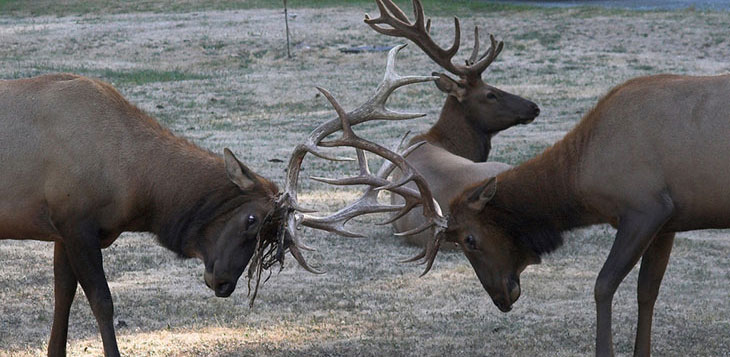Battling Elk, Competitive Coyotes And The Soviet Union

(Inside Science) -- The world is full of creatures that are extremely competitive, sometimes even aggressive, and those that are laid-back and happy to let the competitive ones face off for resources. The latter will just take what's left over -- and sometimes those animals happily thrive.
A group of European scientists, using computer modeling, have worked out the dynamics of competition within a species and shown how it often ebbs and flows -- and can sometimes lead to extinction.
Those animals without a competitive instinct often make better use of resources than do the competitive ones, the scientists reported in Nature Communications. But, the drive for competitive behavior often is triggered by the females of the species preferring the alpha male approach, even to the point of ignoring males that would make better mates. Therein, the scientists found, lies danger.
While the study, by Sebastian Baldauf, of the Institute for Evolutionary Biology and Ecology at the University of Bonn, Franjo Weissing of the Centre for Ecological and Evolutionary Studies at the University of Groningen in the Netherlands, and Leif Engqvist at the Abteilung Evolutionsbiologie at the University of Bielefeld in Germany dealt with non-humans, much of it applies.
The scientists put several variables into the computers and assumed there is a gene for competitiveness. Then, they added variables and turned the game on, something like the computer game of Civilization. They know life is more complicated than that -- there is no one gene for competitiveness -- but doing it this way made watching what happens clearer.
"We assumed a population with a rotating set of players," Baldauf said. "Within a species there is variation. This gene is allowed to evolve through evolutionary time."
The creatures produced by the model included those whose competitiveness led them to put energy into producing weapons like horns or antlers on male moose and elk, or to grow to huge sizes like sunfish. Initially, the population is stable and efficient until at some point a "mutation" occurs and competitive creatures are born that upset the stability.
"Virtually all features enhancing competitive ability come at a cost," the researchers wrote. One example is trees, Baldauf said. In a forest you will see very tall trees that overshadow the smaller trees but do not have an abundance of leaves, and small trees with more leaves. There is not enough energy to both grow tall and grow large numbers of leaves.
Under normal circumstances, the competitiveness will lead to differences within the species. One result of that is diversification: One group does not invest in competition at all and is content with lower-quality resources, and a second type that invests an appreciable but not maximal part of their energy into being competitive. If much is at stake, such coexistence does not occur. Instead, the model predicts cyclical changes in competitive ability over time.
For large periods, there is an arms race to the top, leading an ever-increasing degree of competitiveness in the population. This process continues until the costs of competitiveness come too high and competitiveness crashes to zero. Once that happens, the whole rat race starts again, he said.
But, females tend to mate with males that are competitive even if a more laid-back male would be safer, so there is pressure on the males to compete in order to succeed. Bright colors and weapons are aids in competing in matters of sexual selection. Competitive males (and probably females) are inefficient in their use of resources.
These preferences, in turn, fuel the males’ arms race towards higher levels of competitiveness.
"Even stable coexistence is destabilized and driven to cycles, and at some point, when conditions are hard, the competition costs get too high and the population goes to hell," Baldauf said.
Remember when the Soviet Union collapsed in 1991, in part because the Soviets couldn’t afford to compete with the United States for weapons? They were impelled to compete but made insufficient use of their resources and finally had to give up. Yet there are many countries that are not competitive in the world that make out fine because they make better use of what they have.
Baldauf said the same rules seem to apply whether the organisms are social animals, like wolves and coyotes, or solitary animals like bears or leopards. Competitiveness, he added, does not necessarily mean aggression.
Marc Bekoff, professor emeritus of ecology and evolutionary biology at the University of Colorado Boulder, agreed. Bekoff, who spent much of his life studying coyotes in the Rocky Mountains, said that for those animals the highest ranking male is not necessarily the most aggressive.
Some animals are born into leadership like princes becoming kings. Sometimes it is the result of social interactions that do not include aggression. Sometimes threats and displays work.
Bekoff said the mechanics of leadership and competition are not well-known. Much of the research that has been done is with animals in captivity and those creatures may behave differently than if they were in the wild because in captivity they can’t get away from each other.
What research has been done in the wild shows that most animals are more cooperative with each other than competitive, but research has been sparse.
Models like the German-Dutch one are interesting for generating new studies, he said.
"There is no doubt that animals compete with one another, but competition is not as violent or as bloody as a lot of people assume."

